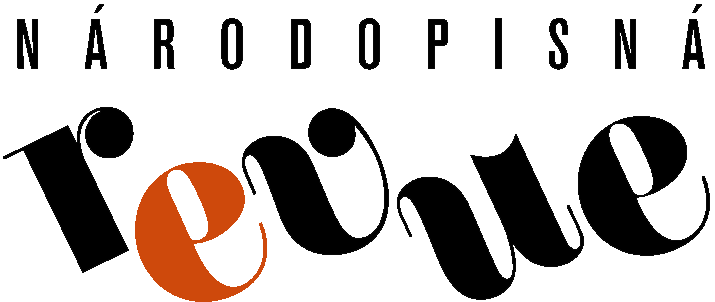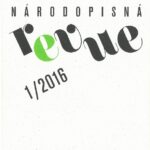Journal of Ethnology 1/2016 is devoted to the theme Humour and Comic. In her study, Barbora Půtová writes about the history of presentation of exotism in European countries, which developed in the 19th century in connection with the colonial expansion of the Europeans and which accentuated differences in native ethnic groups in terms of absurdity and comicality (Freak Shows in the Context of the Period Comic). Jana Poláková deals with printed humour in folk reading calendars (Women as Objects of Printed Jokes in Selected Volumes of Vilímek’s Calendar – a Supplement to the Humoristické Listy Magazine). Juraj Hamar analyses comic scenes and characters in the Slovakian traditional puppet theatre based on texts coming from the theatre of the Anderle family from Radvan (Structure of Comic Images in Traditional Puppet Theatre in Slovakia). The study written by the Polish ethnomusicologist Piotr Dahlig and included outside of the theme is devoted to music folklorism and its broader connections (Music Folklorism in Poland: a historical review).
In the Transforming Traditions column, Eva Večerková pays attention to the development of kermesse festivals in a selected location in western Moravia (St. Martin Kermesse Festival in Zubří near Nové Město na Moravě). Interview Section introduces the ethnologist Karel Pavlištík (born 1931) on the occasion of his life jubilee. Social Chronicle remembers jubilees of the ethnologists Alexandra Navrátilová (born 1946), Lubomír Procházka (born 1956), Mirjam Moravcová (born 1931), Mikuláš Mušinka (born 1936) and the architect Jiří Škabrada (born 1946). It also publishes an obituary for the ethnologist Štefan Mruškovič (1932–2016) and the singer of folk songs Václav Harnoš (1930–2015). Other regular sections inform about exhibitions, conferences, festivals and new publications in the branch.
Freak Shows in the Context of the Period Comic
The paper focuses on ethnologic and cultural-anthropologic analysis of freak shows. This was one of the forms of Eurocentric and inhumane approach to corporal and cultural dissimilarities in members of extra-European cultures, or physically handicapped people whose differences became a subject of exhibitions and other forms of public presentations. The freak shows accentuated particularly exotic features of different individuals, their morphological dissimilarities and any other deviations and anomalies differing from the standards related to European population. The paper describes, analyses and interprets historical, cultural, social and power factors and causes which made it possible to turn “the others” into a subject of amusement, astonishment and comic. The paper presents principles and strategies employed by freak shows, mostly determined by their impresarios (Phineas Taylor Barnum, Carl Hagenbeck, Albert Geoffroy Saint-Hilaire, William Leonard Hunt). In addition to circuses, zoological gardens and wax museums, the paper does not ignore the influence these freak shows had on theatres, music halls and cabarets. The final part of the paper reveals the inhumane message of freak shows which were grounded on ideological and power construction of Eurocentric cultural standards and values. The aim of the paper is to draw attention to a frequently omitted field of ethnology and cultural anthropology, as well as to the negative consequences resulting from constructing “the others” in the context of mass entertainment and the comic.
Women as Objects of Printed Jokes in Selected Volumes of Vilímek’s Calendar – a Supplement to the Humoristické Listy Magazine
The focus of the study is on nine volumes of selected folk reading calendars which were issued between 1889 and 1911. The essay offers an overview of basic types and forms of anecdotes and jokes which could be find in the chosen volumes of the calendar, and their graphical and language means. The contribution presents anecdotes, which were concentrated on women, and uses them to indicate the then society’s understanding of women and their position within the society and family. All selected volumes of Vilímek’s calendar gave a clear feeling of several rooted and only slowly changing stereotype images about women. Some storylines, figures or points had not changed for decades; some others change or cease to exist at the moment when they are no longer actual. While the oral tradition allows a joke to flexibly response to a change, the printed versions are preserved once for all. On the one hand, their relation to the time when they were published allows us an original insight. On the other hand, the point sometimes fully disappears without more detailed knowledge of period cultural and social relations.
Structure of comic images in traditional puppet theatre in Slovakia
The submitted paper is an aesthetic and ethno-theatrological reflection on the theatre repertoire offered by traditional folk puppeteers in Slovakia. It is grounded on an analysis of nearly thirty plays from the repertoire of a dynasty of traditional Slovakian puppeteers – the Anderle family from Radvan. Based on the material acquired through transcription and reconstruction of the corresponding texts, the author focused on the structure of comic images, especially on the comic of characters, the situation comic and the verbal comic. The author also defines the genre of traditional puppet theatre within a broader ethno-theatrological context, and classifies the typology of characters in traditional puppet theatre with the emphasis put on their semantic, visual and phonic sensual-semantic layer. Special attention is paid to Jung’s concept of archetype of a comic character (Trikster) that is represented by the character of Gašparko in the given cultural environment. A philosophical and aesthetical discourse about the comic is completed by an analysis of the comic image’s poetry illustrated by short fragments from selected texts.
Musical folklorism in Poland: a historical review
The aim of the article is to show how the ethno/musicologists, folklorists, music teachers, broadcasting people a.o. have influenced traditional peasant culture in time of basic transformation during the 20th century, and how they have contributed to its documentation and understanding. This review has an exemplary character. Each European country has its own history in this respect. The text has three parts. In the first one, the folklore is confronted with a social history, especially with the process of withdrawal of the isolation in peasants communities and with the filtering of traditional music while it gained new realms of circulation. The second one is dedicated to generations of ethnomusicologists, who created and discovered new topics enlarging the range of ethnomusicology and concept of folklorism towards the cultural and social studies. The third part is connected with contemporary functions of music traditions and roles of ethnomusicologists with the stress on the applied ethnomusicology. The comments on the applied ethnomusicology summarize the author’s experience gained during field research since 1975 and try to present how the past in the realm of traditional culture and music is transformed in the contemporaneity or, rather, how the history becomes united within the contemporary time. The text is closed with a self-reflection of the ethnomusicologist, because “objective” folklore studies are hardly to be imagined, and the individual self-criticism remains as well useful as necessary.



